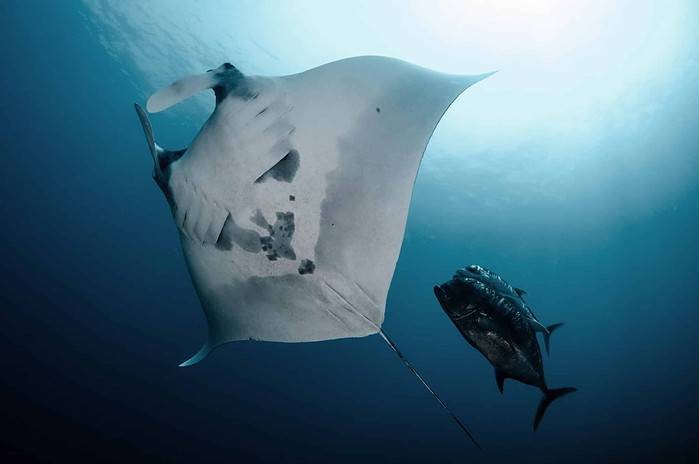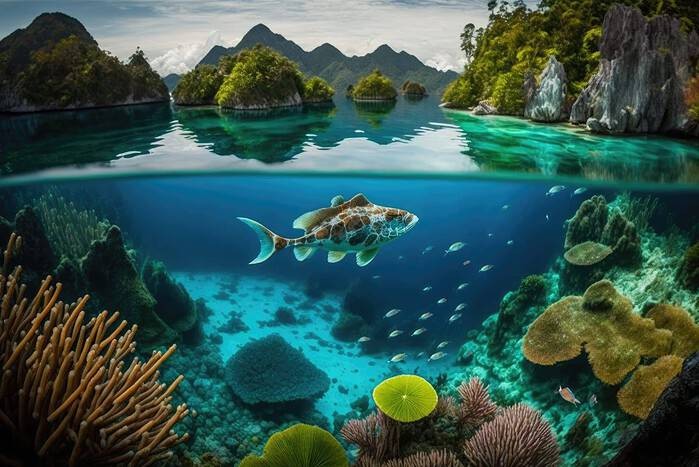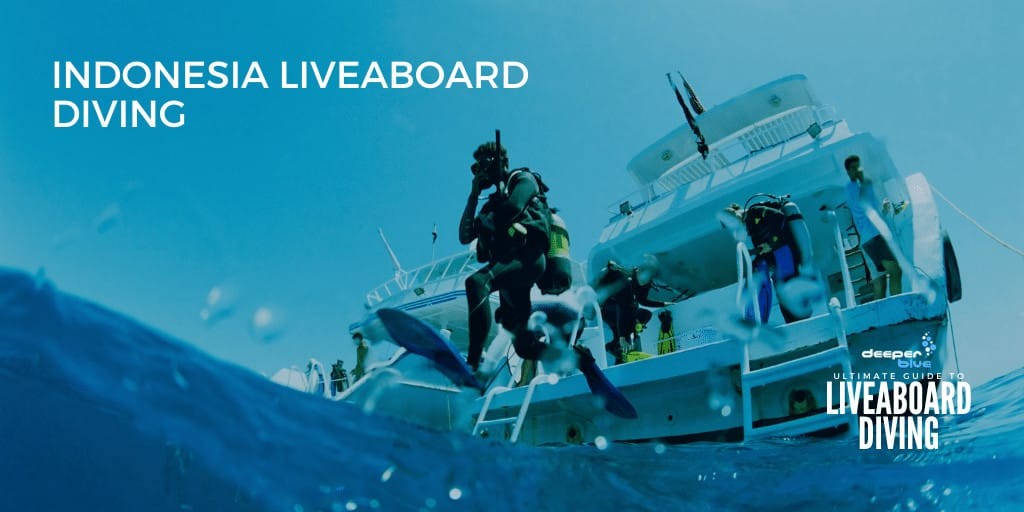Indonesia Liveaboard Diving is part of the Ultimate Guide to Liveaboard Diving
This page contains references to products from one or more of our advertisers. We may receive compensation when you click on links to those products. For an explanation of our Advertising Disclosure Policy, visit this page.
Indonesia is a world-renowned liveaboard destination for its spectacular marine biodiversity; with a destination that boasts so much variety and marine biodiversity, you might have to consider multiple visits to Indonesia.
Indonesia has over 18,000 islands, making it the largest archipelago in the world! A gathering point for The South China Sea, Indian, and Pacific Oceans makes it home to an abundance of life, up to 600 coral species, and 3000 fish species for divers to marvel at!
Liveaboard diving in Indonesia has something of every type of diver and divers of all skill levels! Should you like brisk drift dives, tiny critters, bigger life like sharks or manta rays, or to enjoy some unspoiled underwater terrain, you are looking at the right liveaboard destination!
Indonesia Liveaboard Routes
With so many islands, Indonesia offers endless possibilities and almost too much to explore within one lifetime! So much variety could cause some overwhelm when it comes to deciding which route is the best one suited for you, so let’s break it down into the main routes:
Komodo
Komodo is a top-rated dive site in Indonesia, and rightfully so!
The Natural Park protects the waters of Komodo because of the abundance of life on the reefs and the pelagic fish that can be encountered on dives. There are ample islands to visit and explore underwater, which allows divers to explore a vast diversity of dive sites within the national park!
Check prices for Komodo Itinerary Liveaboards
Some dive sites in Komodo are:
- Rinca Island – A trip to Rinca Island lets you see Komodo dragons on the beach. Underwater, you can expect to see a large variety of corals, nudibranchs, and smaller critters, making it the ideal site for macro photography!
- Manta Alley & Manta Point – These two dive sites in the Komodo National Park allow you to encounter Manta Rays in big numbers! It is a spectacle that you wouldn’t want to miss!
- Bantu Balong – Bantu Balong is also known as the “current city.” The nickname of this dive site already shows that it is a site not to miss! Underwater you will be met with a healthy coral reef bursting with colors, brimming with fish life and reef sharks.

Banda Sea
Taking the Banda Sea itinerary allows you to take a dive safari off the beaten track and to a region where the waters have stayed ably untouched.
You will find a vast number and range of dive sites within the region, which is one of the key reasons why diving in the Banda Sea is genuinely considered a divers paradise!
Check prices for Banda Sea Itinerary Liveaboards
Here are a few exceptional dive sites:
- Pulau Ai – Pulau Ai is one of the best shark diving spots in the Banda Sea. Here you can have swift hammerhead encounters and even schooling yet elusive thresher sharks that might also decide to show up to the dive party!
- Gunung Api – This is a must-dive for anyone diving in the Banda Sea! In the 1980s, a volcanic eruption destroyed an extensive area of the reef; however, the regrowth of the reef makes it so spectacular. You also can encounter shoals of mobula rays brought in by stronger currents.
- Manuk Island – If you are a sea snake fan, then Manuk Island is the perfect dive site for you! Here you can encounter several rare breeds of sea snakes; it is the ideal place for underwater videographers and naturalists. You can also encounter dense shoals of fish, including jacks and barracuda.
Raja Ampat
Not much can compare to the rich biodiversity that Raja Ampat has to offer! In 2002 it was declared the most biodiverse place in the world, and over a thousand different fish species call the marine park area home, as well as five hundred different corals!
Check prices for Banda Sea Itinerary Liveaboards
Raha Ampat offers an array of dive sites; here are some not to be missed:
- Misool Island – Misool Island, also known as the kaleidoscope, is notorious for the burst of colors across the reefs. The big variety of corals occupied by all sorts of critters and reef fish makes it an oasis for macro lovers. Here you will find ghost fish, pygmy seahorses, and nudibranchs of all colors!
- Waigeo – Waigeo is also adorned with an array of fish life! Here you will get a quick glimpse of juvenile emperor angelfish, clownfish, and lionfish!
- Mansuar – Maunsuar is where you encounter bigger marine life, like groups of manta rays, along with turtles frequently passing by and a variety of fish life and colorful corals!
- Cenderawasih Bay – This is the optimal spot to find whale sharks! There is a deeper connection here between the fisherman who believes and luck and the whale sharks. They usually would give fish to the whale sharks in hopes of bringing luck, which means you can encounter several in the area!

Flores
The underwater world of Flores is characterized by steep walls, beautiful corals, gorgonian fans, excellent visibility, and exceptionally diverse marine life.
Check prices for Flores Itinerary Liveaboards
Here are some of the dive sites in the Flores Sea:
- Babi Island – Babi Island is home to a thriving reef wall plummeting to a depth of 50 meters. The reef’s inhabitants are Parrotfish, angelfish, several species of moray eel, and ribbon eels.
- Lambata Island – Here you will find boulders covered in corals and reefs encamping schools of angelfish, parrotfish, fusiliers, and pygmy seahorses.
- Wai Terang – You will dive into history by finding a Japanese WWII freighter underwater. It is home to hard and soft corals and numerous small reef fish.
Triton Bay
Another remote and untouched gem of Indonesia is Triton Bay. Underwater you will find a rocky terrain and large seamounts that attract ample shoals of fish and rocks covered with soft coral gardens.
Let’s not overlook bigger and more predatory species, such as oceanic white-tip sharks and barracuda.
Check prices for Triton Bay Itinerary Liveaboards
Dive sites in Triton Bay:
- Bo’s Rainbow – This is usually a sheltered site with little to no current. Underwater you will be met with infinite coral gardens and soft corals attracting amply fish schools.
- Saruenus Island – This island offers four key dive sites, each with different characteristics depending on what the current is doing. Here you will find Little Komodo with rocky landscapes and boulders that break the surface, and here you will encounter shoals of fish and soft corals and tucked away corners for macro species to hide. You will also get to visit the dive site called Aquarium, which makes for a thrilling drift dive along a wall and is filled with soft coral bommies.
Best Time To Visit For An Indonesia Liveaboard
Indonesia is considered a year-round destination; however, this only accounts for several liveaboard routes such as Bali, Flores, and Komodo. Other regions have different high seasons.
Here is a breakdown of Indonesia’s high seasons:
Komodo/Flores
- High season: March – October
- Low season: February
Banda Sea
- High season: March – April & September – December
- Low season: July – August
Raja Ampat
- High Season: October – April
- Low Season: July – September
Triton Bay
- High Season: October – April
- Low Season: July – September
Marine Encounters While On An Indonesia Liveaboard
By now, it is clear that Indonesia has something for divers of all kinds!
Large animals that you can encounter in Indonesia are Whale sharks, Hammerhead sharks, Thresher sharks, and a variety of reef sharks.
You can also encounter Manta rays, Mola mola, bump head parrotfish, Napolean wrasse, and schools of pelagic fish.
As for smaller critters, the rocky landscapes host seahorses, nudibranchs, frogfish, and octopuses, among several other small critters.
Cuisine Onboard An Indonesia Liveaboard
The cuisine on board is typically locally sourced and delicious Indonesian dishes, but western orientated dishes are also served.
Types Of Indonesia Liveaboards
You will find various types of liveaboards in Indonesia, from the traditionally built phinisi or luxury monohull steel or wooden motor yachts; this destination has a vessel fit for any diver!
Whichever type of boat you choose, you can expect a comfortable stay, including sundecks, indoor lounges and dining areas, twin or double guest cabins, and well-set-up dive decks.
Check prices for Indonesia Liveaboards
How Many Dives A Day?
Usually, you will do 3 – 4 dives a day. On some days, there will be an optional night dive.
Dive Certification Requirements
Indonesia welcomes divers of all levels. Most areas offer easy and sheltered diving, and some liveaboards are snorkeler-friendly!
As for divers looking for more advanced and adventurous dives, there are more demanding dives on deeper reefs, drift dives, and drop-offs.
Your Nitrox certification comes highly recommended as some liveaboards offer nitrox.
Other Useful Information For Indonesia Liveaboard Diving
Entry into Indonesia
There are many different airports to enter Indonesia, the airport you will fly into depends on which liveaboard route you take.
Some nationalities are exempt from obtaining a visa to enter Indonesia; others must obtain a visa before or upon arrival. To get a tourist visa, you must have a valid passport for at least six months, proof of an outbound or onward ticket, and an application fee.
Currency
The local currency in Indonesia is the Indonesian rupiah, and you can exchange your currency for Indonesian rupiah at the airport or in local exchange bureaus.
Getting Around
Transfers are often included in your liveaboard booking. If you would like to explore Indonesia before or after your liveaboard trip, there are many different modes of transport, such as Taxis, buses, Metro (In the cities), and boats for island hopping.
Tips
Tipping your boat crew and dive guides at the end of your stay on an Indonesia liveaboard is customary.
If you are ready to find your next Liveaboard holiday, check out our partner Divebooker.com which has all you need to find & book your liveaboard holiday at your fingertips. Book your next liveaboard holiday today.


